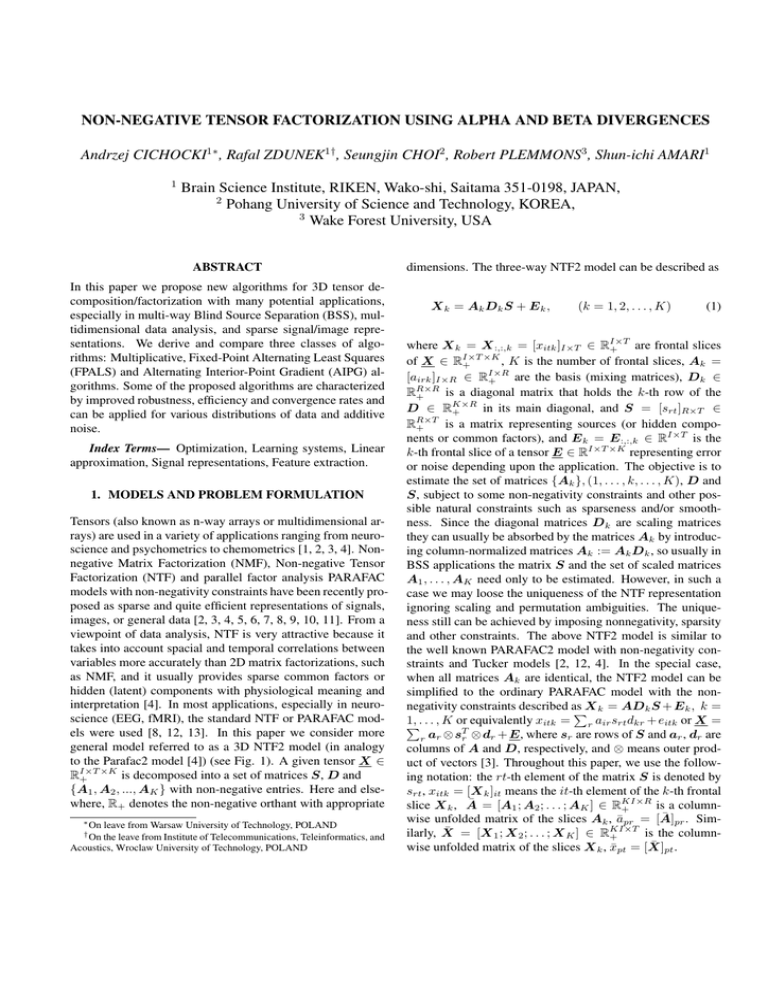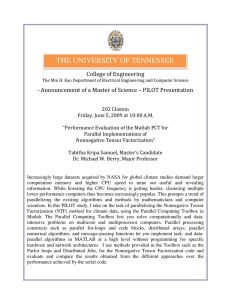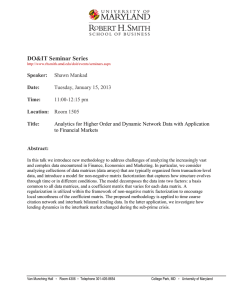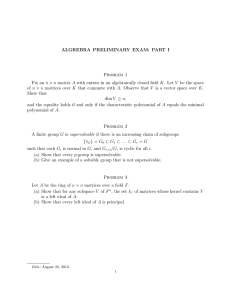NON-NEGATIVE TENSOR FACTORIZATION USING ALPHA AND BETA DIVERGENCES Andrzej CICHOCKI
advertisement

NON-NEGATIVE TENSOR FACTORIZATION USING ALPHA AND BETA DIVERGENCES
Andrzej CICHOCKI1∗ , Rafal ZDUNEK1† , Seungjin CHOI2 , Robert PLEMMONS3 , Shun-ichi AMARI1
1
Brain Science Institute, RIKEN, Wako-shi, Saitama 351-0198, JAPAN,
2
Pohang University of Science and Technology, KOREA,
3
Wake Forest University, USA
ABSTRACT
In this paper we propose new algorithms for 3D tensor decomposition/factorization with many potential applications,
especially in multi-way Blind Source Separation (BSS), multidimensional data analysis, and sparse signal/image representations. We derive and compare three classes of algorithms: Multiplicative, Fixed-Point Alternating Least Squares
(FPALS) and Alternating Interior-Point Gradient (AIPG) algorithms. Some of the proposed algorithms are characterized
by improved robustness, efficiency and convergence rates and
can be applied for various distributions of data and additive
noise.
Index Terms— Optimization, Learning systems, Linear
approximation, Signal representations, Feature extraction.
1. MODELS AND PROBLEM FORMULATION
Tensors (also known as n-way arrays or multidimensional arrays) are used in a variety of applications ranging from neuroscience and psychometrics to chemometrics [1, 2, 3, 4]. Nonnegative Matrix Factorization (NMF), Non-negative Tensor
Factorization (NTF) and parallel factor analysis PARAFAC
models with non-negativity constraints have been recently proposed as sparse and quite efficient representations of signals,
images, or general data [2, 3, 4, 5, 6, 7, 8, 9, 10, 11]. From a
viewpoint of data analysis, NTF is very attractive because it
takes into account spacial and temporal correlations between
variables more accurately than 2D matrix factorizations, such
as NMF, and it usually provides sparse common factors or
hidden (latent) components with physiological meaning and
interpretation [4]. In most applications, especially in neuroscience (EEG, fMRI), the standard NTF or PARAFAC models were used [8, 12, 13]. In this paper we consider more
general model referred to as a 3D NTF2 model (in analogy
to the Parafac2 model [4]) (see Fig. 1). A given tensor X ∈
×K
RI×T
is decomposed into a set of matrices S, D and
+
{A1 , A2 , ..., AK } with non-negative entries. Here and elsewhere, R+ denotes the non-negative orthant with appropriate
∗ On
leave from Warsaw University of Technology, POLAND
† On the leave from Institute of Telecommunications, Teleinformatics, and
Acoustics, Wroclaw University of Technology, POLAND
dimensions. The three-way NTF2 model can be described as
X k = Ak D k S + E k ,
(k = 1, 2, . . . , K)
(1)
where X k = X :,:,k = [xitk ]I×T ∈ RI×T
are frontal slices
+
I×T ×K
of X ∈ R+
, K is the number of frontal slices, Ak =
[airk ]I×R ∈ RI×R
are the basis (mixing matrices), D k ∈
+
RR×R
is
a
diagonal
matrix that holds the k-th row of the
+
K×R
D ∈ R+
in its main diagonal, and S = [srt ]R×T ∈
RR×T
is
a
matrix
representing sources (or hidden compo+
nents or common factors), and E k = E :,:,k ∈ RI×T is the
k-th frontal slice of a tensor E ∈ RI×T ×K representing error
or noise depending upon the application. The objective is to
estimate the set of matrices {Ak }, (1, . . . , k, . . . , K), D and
S, subject to some non-negativity constraints and other possible natural constraints such as sparseness and/or smoothness. Since the diagonal matrices D k are scaling matrices
they can usually be absorbed by the matrices Ak by introducing column-normalized matrices Ak := Ak D k , so usually in
BSS applications the matrix S and the set of scaled matrices
A1 , . . . , AK need only to be estimated. However, in such a
case we may loose the uniqueness of the NTF representation
ignoring scaling and permutation ambiguities. The uniqueness still can be achieved by imposing nonnegativity, sparsity
and other constraints. The above NTF2 model is similar to
the well known PARAFAC2 model with non-negativity constraints and Tucker models [2, 12, 4]. In the special case,
when all matrices Ak are identical, the NTF2 model can be
simplified to the ordinary PARAFAC model with the nonnegativity constraints described as
PX k = AD k S + E k , k =
1,
.
.
.
,
K
or
equivalently
x
=
itk
r air srt dkr + eitk or X =
P
T
where
s
are
rows of S and ar , dr are
a
⊗
s
⊗
d
+
E,
r
r
r
r
r
columns of A and D, respectively, and ⊗ means outer product of vectors [3]. Throughout this paper, we use the following notation: the rt-th element of the matrix S is denoted by
srt , xitk = [X k ]it means the it-th element of the k-th frontal
slice X k , Ā = [A1 ; A2 ; . . . ; AK ] ∈ RKI×R
is a column+
wise unfolded matrix of the slices Ak , āpr = [Ā]pr . Similarly, X̄ = [X 1 ; X 2 ; . . . ; X K ] ∈ RKI×T
is the column+
wise unfolded matrix of the slices X k , x̄pt = [X̄]pt .
K
(a)
1
R
K
k
i
X
I
1
t
AK
A2
T
1
eralization of the exponentiated gradient (EG) [7]:
D
A1
=
1
T
(α)
S
1
Φ(airk ) ←
T
...
R
=
(I x T )
Ak
Dk
S
(R x R)
( R x T)
(I x R)
Fig. 1. (a) NTF2 model in which a 3D tensor is decomposed
into a set of non-negative matrices: {A1 , . . . , AK }, D, S.
(b) Equivalent representation in which frontal slices of a tensor are factored by a set of matrices (tensor E representing
error is omitted for simplicity).
∂DAk (X k ||Ak S)
, (2)
∂Φ(airk )
(α)
Φ(srt ) ←
(b)
Xk
Φ(airk ) − ηirk
Φ(srt ) − ηrt
∂DA (X̄||ĀS)
,
∂Φ(srt )
(3)
where Φ(x) is a suitably chosen function.
It can be shown that such a nonlinear transformation provides a stable solution and the gradients are much better behaved in the space Φ. In our case, we employ Φ(x) = xα ,
which leads directly to the new learning algorithm (for α 6= 0)
(the rigorous proof of local convergence similar to this given
by Lee and Seung [11] is omitted due to a lack of space):
ÃP
!1/α
α
(xitk /[Ak S]it ) srt
airk ← airk
, (4)
PT
t=1 srt
à PKI
¡
¢α !1/α
p=1 āpr x̄pt /[ĀS]pt
srt ← srt
. (5)
PKI
p=1 āpr
T
t=1
2.2. β-divergence
2. ALPHA AND BETA DIVERGENCES
To deal with the model (1) efficiently we adopt several approaches from constrained multi-criteria optimization, where
we minimize simultaneously several cost functions using alternating switching between sets of parameters. The α and
β-divergences are two complimentary generalized cost functions which can be applied for NMF and NTF [1, 6, 7, 8].
2.1. α-divergence
Let us consider a flexible and general class of the cost functions, called α-divergence [1, 6]:
P
Regularized β-divergence [14] for the NTF2 problem can be
defined as follows:
D(β) (X̄||ĀS) =
X
x̄βpt − [ĀS]βpt
(x̄pt
β(β + 1)
pt
[ĀS]pt − x̄pt
) + αS kSkL1 ,
β+1
X
xβ − [Ak S]βit
(β)
Dk (X k ||Ak S) =
(xitk itk
β(β + 1)
it
+[ĀS]βpt
(6)
[Ak S]it − xitk
) + αAk kAk kL1 ,
(7)
β+1
k = 1, . . . , K, t = 1, 2, . . . , T, i = 1, 2, . . . , I,
+[Ak S]βit
− αx̄pt + (α − 1)[ĀS]pt ) where αS and αAk are small positive regularization parameters which control the degree of sparseness of the matrices S
α(α − 1)
and Ak , respectively, and the
P
PL1-norms defined as ||S||L1 =
|s
|
and
||A
||
=
rt
k
L1
ir |airk | are introduced to enrt
force
sparse
representations
of
the solutions. It is interesting
X xα [Ak S]1−α
xitk
[Ak S]it
(α)
it
itk
to note that for β = 1, we obtain the squared Euclidean disDAk (X k ||Ak S) =
−
+
α(α − 1)
α−1
α
tances expressed by the Frobenius norms kX k − Ak Sk2F ,
it
while for the singular cases, β = 0 and β = −1, the βWe note that as special cases of α-divergence for α = 2, 0.5, −1, divergence has to be defined as limiting cases as β → 0
we obtain the Pearson’s, Hellinger’s and Neyman’s chi-square
and β → −1, respectively. When these limits are evaluated
distances [6], respectively. Evaluating the limits for α → 1
one gets for β → 0 the generalized KL divergence, and for
and α → 0, one obtains the generalized Kullback-Leibler
β → −1 we obtain the Itakura-Saito distance. The choice of
(KL) divergence (I-divergence) and the dual generalized KL
the parameter β depends on the statistical distribution of the
divergence, respectively [6, 7, 8].
data and the β-divergence corresponds to the Tweedie modInstead of applying the standard gradient descent method,
els [14]. For example, the optimal choice of the parameter
we use the nonlinearly transformed gradient approach as genfor the normal distribution is β = 1, for the γ-distribution
(α)
DA (X̄||ĀS)
=
1−α
α
pt (x̄pt [ĀS]pt
is β → −1, for the Poisson distribution β → 0, and for
the compound Poisson β ∈ (−1, 0). By minimizing the βdivergence, we have derived various kinds of NTF algorithms:
Multiplicative based on the standard gradient descent, Exponentiated Gradient (EG), Projected Gradient (PG), Alternating Interior-Point Gradient (AIPG), or Fixed Point Alternating Least Squares (FPALS) algorithms. For example, in order
to derive a flexible multiplicative learning algorithm, we compute the gradient of (6)-(7) with respect to elements of matrices srt = sr (t) = [S]rt and airk = [Ak ]ir and performing
simple mathematical manipulations we obtain the multiplicative update rules:
PT
[ t=1 (xitk /[Ak S]1−β
it ) srt − αAk ]ε
airk ← airk
,(8)
PT
β
t=1 [Ak S]it srt
PKI
[ p=1 āpr (x̄itk /[ĀS]1−β
it ) − αS ]ε
, (9)
srt ← srt
PKI
β
p=1 āpr [Āk S]it
3. SIMULATION RESULTS
All the NMF algorithms discussed in this paper have been extensively tested for many difficult benchmarks for signals and
images with various statistical distributions and also for real
EEG data. We found the best performance can be obtained
with the AIPG, FPALS and the algorithm (8)-(9) for β = 1.
Due to space limitation, we present here only one simulation example. Nine natural highly correlated images are
.
mixed by a randomly generated 3D tensor A ∈ R18×9×10
+
The observed mixed data are collected in 3D tensor X ∈
2
×10
R18×256
. The exemplary results are shown in Fig.2.
+
where [x]ε = max{ε, x} with a small ε = 10−16 is introduced in order to avoid zero and negative values.
In the special case for β = 1 we have derived a new alternative algorithm, called regularized FPALS (Fixed Point
Alternating Least Squares) algorithm (see [8] for details)
h
i
Ak ← (X k S T − αAk E A )(SS T + γS E)+ , (10)
h
i ε
T
T
+
S ← (Ā Ā + γA E) (Ā X̄ − αS E S ) , (11)
ε
where γA , γS are small nonnegative regularization coefficients
(typically, decaying to zero during iteration process), A+ denotes Moore-Penrose pseudo-inverse of A and E A ∈ RI×R ,
E S ∈ RR×T , E ∈ RR×R are matrices with all entries one.
Furthermore, using the Alternating Interior-Point Gradient (AIPG) approach [15], another efficient algorithm has been
developed and implemented [8]:
Ak ← Ak − ηAk P Ak ,
(12)
S ← S − ηS P S ,
(13)
³
´ ³
´
where P Ak = Ak ® (Ak SS T ) ¯ (Ak S − X k )S T ,
³
´ ³
´
T
T
P S = S ® (Ā ĀS) ¯ Ā (ĀS − X̄) and signs ¯ and
® mean component-wise multiplication and division, respectively. The learning rates ηAk and ηS are selected in this way
to ensure the steepest descent, and on the other hand, to maintain non-negativity. Thus, ηS = min{τ η̂S , ηS∗ } and ηAk =
∗
min{τ η̂Ak , ηA
}, where τ ∈ (0, 1), η̂S = {η : S − ηP S }
k
and η̂Ak = {η : Ak − ηP Ak } ensure non-negativity, and
∗
ηA
k
=
vec(P Ak )T vec(Ak SS T − X k S T )
, (14)
vec(P Ak S)T vec(P Ak S)
ηS∗
=
vec(P S )T vec(Ā ĀS − Ā X̄)
vec(Ak P S )T vec(Ak P S )
T
T
are the adaptive steepest descent learning rates.
(15)
(a)
(b)
Fig. 2. Example: (a) 9 original source images; (b) estimated
source images using FPALS algorithm (SIR = 32.9, 5.1, 45,
18.8, 28.2, 24.5, 42.2, 37.8, 27.1 [dB], respectively).
Table 1. Mean SIRs in [dB] obtained from 100 MC samples
for estimation of the columns in the tensor A ∈ RI×R×K and
the rows (sources) in S ∈ RR×T for the selected algorithms.
The right column presents the elapsed times [in seconds] for
a simple MC sample.
ALGORITHMS:
A
S Times [s]
Alpha Alg. (4) – (5): α = 0.5 21 17.9
31.7
Beta Alg. (8) – (9): β = 1 20.8 17.8
7.6
AIPG (12) – (15)
27.2 25
4.7
24.5 23.3
1.8
FPALS (10) – (11)
4. CONCLUSIONS AND DISCUSSION
In this paper we proposed generalized and flexible cost functions (controlled by a single parameter α or β) that allows
us to derive a family of robust and efficient NTF algorithms.
The optimal choice of a free parameter in a specific cost function depends on a statistical distribution of data and additive
noise, thus various criteria and algorithms (updating rules)
should be applied for estimating the basis matrices Ak and
the source matrix S, depending on a priori knowledge about
the statistics of noise or errors. It is worth mentioning that we
can use three different strategies to estimate common factors
(the source matrix S). In the first approach, presented in this
paper, we use two different cost functions: a global cost function (using unfolded column-wise matrices: X̄, Ā for frontal
slices of 3D tensors) to estimate the common factors S, i.e.,
the source matrix S; and local cost functions to estimate the
slices Ak , (k = 1, 2, ..., K). However, instead of using the
unfolded matrices for the NTF2 model to estimate
S, we can
c = P X k ∈ RI×T
use the averaged matrices defined as X
k
b = P Ak ∈ RI×R . Furthermore, it is also possiand A
k
ble to apply a different approach by using only a set of local
cost functions, e.g., Dk (X k ||Ak S) = 0.5||X k − Ak S||2F .
In such a case, we estimate Ak and S cyclically by applying alternating minimization (similar to row-action projection
of the Kaczmarz algorithm). We found that such approaches
also work quite well for the NTF2 model. The advantage of
the last approach is that all the update learning rules are local
(slice by slice) and algorithms are generally faster for large
data, (especially, if K >> 1).
Obviously, 3D NTF models can be transformed to a 2D
non-negative matrix factorization (NMF) problem by unfolding (matricizing) tensors. However, it should be noted that
such a 2D model is not exactly equivalent to the NMF2 model,
since in practice we often need to impose different additional
constraints for each slice. In other words, the NTF2 model
should not be considered as equal to a standard 2-way NMF
of a single unfolded 2-D matrix. The profiles of the stacked
(column-wise unfolded) Ā are often not treated as single profiles and the constraints are usually applied independently to
each Ak sub-matrix that form the stacked Ā. We have been
motivated to develop the proposed NTF algorithms for use in
three areas of data analysis (especially, EEG data) and signal/image processing: (i) multi-way blind source separation,
(ii) model reduction and selection, and (iii) sparse image coding. The proposed models can be further extended by imposing additional, natural constraints such as smoothness, continuity, closure, unimodality, local rank, selectivity, and/or by
taking into account a prior knowledge about specific 3D, or
more generally, multi-way data. Obviously, there are many
challenging open issues remaining, such as global convergence, optimal choice of parameters and uniqueness of a solution when additional constraints are imposed.
5. REFERENCES
[1] S. Amari, Differential-Geometrical Methods in Statistics, Springer Verlag, 1985.
[2] L. De Lathauwer and P. Comon (Eds.), “Workshop on
Tensor Decompositions and Applications,” CIRM, Marseille, France, 2005.
[3] M. Heiler and C. Schnoerr, “Controlling sparseness in
nonnegative tensor factorization,” in ECCV, Springer
LNCS, 2006, vol. 3951, pp. 56–67.
[4] A. Smilde, R. Bro, and P. Geladi, Multi-way Analysis:
Applications in the Chemical Sciences, John Wiley and
Sons, New York, 2004.
[5] M. Berry, M. Browne, A. Langville, P. Pauca, and
R. Plemmons, “Algorithms and applications for approximate nonnegative matrix factorization,” Computational
Statistics and Data Analysis, 2007, to appear, available
at: http://www.wfu.edu/∼plemmons.
[6] A. Cichocki, R. Zdunek, and S. Amari, “Csiszar’s divergences for non-negative matrix factorization: Family of
new algorithms,” Springer LNCS, vol. 3889, pp. 32–39,
2006.
[7] A. Cichocki, S. Amari, R. Zdunek, R. Kompass,
G. Hori, and Z. He, “Extended SMART algorithms for
non-negative matrix factorization,” Springer LNAI, vol.
4029, pp. 548–562, 2006.
[8] A. Cichocki and R. Zdunek, “NTFLAB for Signal Processing,” Tech. Rep., Laboratory for Advanced Brain
Signal Processing, BSI, RIKEN, Saitama, Japan, 2006.
[9] I. Dhillon and S. Sra, “Generalized nonnegative matrix
approximations with Bregman divergences,” in Neural
Information Proc. Systems, Vancouver, Canada, December 2005.
[10] M. Kim and S. Choi, “Monaural music source separation: Nonnegativity, sparseness, and shift-invariance,”
Springer LNCS, vol. 3889, pp. 617–624, 2006.
[11] D. D. Lee and H. S. Seung, “Learning the parts of objects by nonnegative matrix factorization,” Nature, vol.
401, pp. 788–791, October 1999.
[12] M. Morup, L. K. Hansen, C. S. Herrmann, J. Parnas,
and S. M. Arnfred, “Parallel factor analysis as an
exploratory tool for wavelet transformed event-related
EEG,” NeuroImage, vol. 29, no. 3, pp. 938–947, 2006.
[13] F. Miwakeichi, E. Martnez-Montes, P. A. Valds-Sosa,
N. Nishiyama, H. Mizuhara, and Y. Yamaguchi, “Decomposing EEG data into spacetime-frequency components using Parallel Factor Analysis,” NeuroImage, vol.
22, no. 3, pp. 1035–1045, 2004.
[14] M. Minami and S. Eguchi, “Robust blind source separation by beta-divergence,” Neural Computation, vol. 14,
pp. 1859–1886, 2002.
[15] M. Merritt and Y. Zhang, “An interior-point gradient
method for large-scale totally nonnegative least squares
problems,” J. Optimization Theory and Applications,
vol. 126, no. 1, pp. 191–202, 2005.






